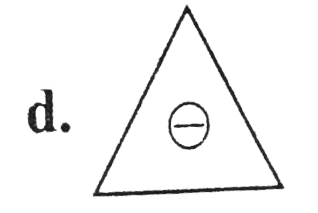Which of the following species will be least stable?




The correct Answer is:d
To determine which of the given species is the least stable, we will analyze each compound based on their aromaticity. Aromatic compounds are more stable, while anti-aromatic compounds are the least stable.
1. Identify the Compounds: We have four compounds to analyze. Let's label them for clarity:
- Compound A
- Compound B
- Compound C
- Compound D
2. Check for Aromaticity: To classify each compound, we will check if they are cyclic, planar, and have a conjugated system of π electrons.
- Aromatic Compounds: Must have (4n + 2) π electrons.
- Anti-aromatic Compounds: Must have 4n π electrons.
3. Analyze Compound A:
- Cyclic: Yes
- Planar: Yes
- Conjugated: Yes
- π Electrons: 6 (which is 4n + 2, where n=1)
- Conclusion: Aromatic and stable.
4. Analyze Compound B (Cyclooctatetraene):
- Cyclic: Yes
- Planar: Yes
- Conjugated: Yes
- π Electrons: 10 (which is 4n + 2, where n=2)
- Conclusion: Aromatic and stable.
5. Analyze Compound C:
- Cyclic: Yes
- Planar: Yes
- Conjugated: Yes
- π Electrons: 6 (which is 4n + 2, where n=1)
- Conclusion: Aromatic and stable.
6. Analyze Compound D:
- Cyclic: Yes
- Planar: Yes
- Conjugated: Yes
- π Electrons: 4 (which is 4n, where n=1)
- Conclusion: Anti-aromatic and least stable.
7. Final Comparison:
- Compounds A, B, and C are aromatic and thus more stable.
- Compound D is anti-aromatic and therefore the least stable.
Answer:
The least stable compound is Compound D (anti-aromatic).
---
- Compound A
- Compound B
- Compound C
- Compound D
- Aromatic Compounds: Must have (4n + 2) π electrons.
- Anti-aromatic Compounds: Must have 4n π electrons.
- Cyclic: Yes
- Planar: Yes
- Conjugated: Yes
- π Electrons: 6 (which is 4n + 2, where n=1)
- Conclusion: Aromatic and stable.
- Cyclic: Yes
- Planar: Yes
- Conjugated: Yes
- π Electrons: 10 (which is 4n + 2, where n=2)
- Conclusion: Aromatic and stable.
- Cyclic: Yes
- Planar: Yes
- Conjugated: Yes
- π Electrons: 6 (which is 4n + 2, where n=1)
- Conclusion: Aromatic and stable.
- Cyclic: Yes
- Planar: Yes
- Conjugated: Yes
- π Electrons: 4 (which is 4n, where n=1)
- Conclusion: Anti-aromatic and least stable.
- Compounds A, B, and C are aromatic and thus more stable.
- Compound D is anti-aromatic and therefore the least stable.
The least stable compound is Compound D (anti-aromatic).
Topper's Solved these Questions
- AROMATIC COMPOUNDS AND ALKYL AND ARYL HALIDES BOOK - CENGAGE CHEMISTRY ENGLISHCHAPTER - AROMATIC COMPOUNDS AND ALKYL AND ARYL HALIDES EXERCISE - Exercises Assertion-Resoning Type
1 Video
- AROMATIC COMPOUNDS AND ALKYL AND ARYL HALIDES BOOK - CENGAGE CHEMISTRY ENGLISHCHAPTER - AROMATIC COMPOUNDS AND ALKYL AND ARYL HALIDES EXERCISE - Exercises Assertion-Resoning
11 Videos
- AROMATIC COMPOUNDS AND ALKYL AND ARYL HALIDES BOOK - CENGAGE CHEMISTRY ENGLISHCHAPTER - AROMATIC COMPOUNDS AND ALKYL AND ARYL HALIDES EXERCISE - Exercises Single Correct Answer Type
28 Videos
- APPENDIX INORGANIC VOLUME 2BOOK - CENGAGE CHEMISTRY ENGLISHCHAPTER - APPENDIX INORGANIC VOLUME 2EXERCISE - Short Answer Type
179 Videos
- BIOMOLECULESBOOK - CENGAGE CHEMISTRY ENGLISHCHAPTER - BIOMOLECULESEXERCISE - Exercises Archives (Analytical And Descriptive)
8 Videos
Similar Questions
Knowledge Check
Which of the following species is least stable ?
ACH4BSiH4CSnH4DPbH4Which of the following species is not stable?
A[Sn(OH)6]2−B[SiCl6]2−C[SiF6]2−D[GeCl6]2−Which of the following halides is least stable and has doubtful existence ?
ACCl4BSnl4CGel4DPbl4
Which of the following species is most stable ?
View SolutionWhich of the following is least stable
View SolutionWhich of the following carbocations is least stable ?
View SolutionWhich of the following oxide is thermaly least stable?
View SolutionIn terms of the molecular orbital theory , which of the following species will most likely be the one to gain an electron to form thermodynamically more stable species?
View Solution
